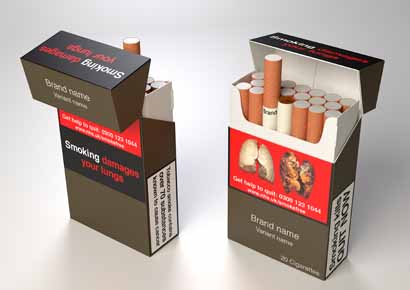The U.K.’s new anti-tobacco measures may not achieve their stated objectives.
By Giles Roca

May 20 saw a series of major changes to the U.K. tobacco market, the most noticeable being the full introduction of standardized or plain packaging. This was accompanied by a suite of other measures, including a ban on all small packs (which previously made up around 75 percent of the U.K. market); a ban on flavored tobacco; new pictorial health warnings; and various restrictions on e-cigarette size, tank size, nicotine liquid strength, etc. On the same day, the government introduced a minimum excise tax.
All of these measures were introduced directly or, in the case of plain packaging, indirectly under the revised EU Tobacco Products Directive (TPD2) that was transposed into U.K. law by David Cameron’s government in May 2016. While TPD2 does not mandate plain packaging, it allows member states to adopt it as a tobacco control measure.
To understand the impact of these measures, the Tobacco Manufacturers’ Association (TMA) undertook three waves of consumer polling of 1,000 smokers. The results should worry all of those involved in law enforcement, those in the U.K. treasury who depend on the annual £12.5 billion ($16.22 billion) in tobacco taxation and of course those legitimate independent retailers for whom tobacco often makes up 30 percent of sales.
Deprived of the ability to purchase smaller and therefore more affordable packs of tobacco, smokers are not, as those in the health lobby claim, simply quitting, but they are moving into buying from the black market or from abroad, thereby avoiding U.K. duty and benefitting the criminal gangs involved in tobacco smuggling. Over the past six months there was a 15 percent increase in smokers buying packs of 20 cigarettes from illicit sources and abroad. Smokers buying larger packs of hand-rolling tobacco from such sources and abroad almost doubled with a 91.7 percent increase. There was a 32 percent increase in smokers buying online from social media and websites advertising cheap illegal tobacco, and there was a 22 percent increase in smokers buying any tobacco product from abroad, thereby avoiding U.K. duty.
Despite how some like to portray it, the tobacco industry does not believe its products should go unregulated. It is clear about the risks involved, and that is why the industry is at the forefront of developing reduced-risk alternatives. However, it is opposed to measures that are proved to not work, where there is no evidence of their effectiveness or where they are more about totem interventions championed by largely taxpayer-funded health lobbyists.
Indeed, on some of these recently introduced measures, the health lobby itself cannot agree on their merits. “People buy smaller pack sizes, such as 10s, when they are attempting to reduce their tobacco consumption and quit,” said Martin Dockrell, then head of policy at the U.K. anti-tobacco lobby group Action on Smoking and Health, in 2008. “If you wanted people to lose weight, you wouldn’t take away fun-sized chocolate bars and only sell jumbos. I’m with the retailers on this one.” Dockrell is now head of tobacco control at Public Health England, the lead agency tasked with promoting good health.
 Plain packaging will simply make it easier to produce counterfeit packaging, while there is no evidence that it has been effective in reducing youth access to cigarettes either in Australia, where it was introduced in 2012, or in France, which introduced it at the start of this year and has seen overall sales actually increase.
Plain packaging will simply make it easier to produce counterfeit packaging, while there is no evidence that it has been effective in reducing youth access to cigarettes either in Australia, where it was introduced in 2012, or in France, which introduced it at the start of this year and has seen overall sales actually increase.
Meanwhile, the restrictions on e-cigarettes will have the perverse effect of deterring those who wish to move off combustible tobacco by reducing the experience available in electronic form. It is notable that the recent U.K. smoking prevalence figures, published in June, show a steeper decline since 2013 thanks to emergence of harm reduction technology such as e-cigarettes. This stands in direct contrast to the tranche of tobacco control measures implemented in the U.K. by successive governments over the past decade, which have had minimal effect on smoking rates and negative consequences such as making the problem of black market tobacco even worse.
The TMA will continue to closely monitor the impact of these measures and is currently conducting a survey of 12,000 smokers across the U.K. that will give unprecedented insight into the impact that they are having. It will make its data fully available for all interested parties to see.
So what lessons can we draw from this? Clearly, don’t believe the hype that some of those in the health lobby both generate and want you to believe. Measures are advocated with scant evidence while their adoption into law has more to do with keeping such groups quiet—a damaging way to make public policy.
We also know that what happens in tobacco will happen sooner or later in other sectors, regardless of any evidence on the effectiveness of the measures—just look at the growing calls for plain packaged food and alcohol both in the U.K. and around the world. We also know what happens in the U.K. will happen sooner or later in other places, particularly following the decision of the U.K. government to provide £15 million to the World Health Organization’s Framework Convention on Tobacco Control to push forward with implementing a U.K. model of tobacco control in other countries.
Given that many of these measures originated in Europe, we will be calling on the government to look again at them as the U.K. leaves the European Union so that we have an approach based not on legislative totems but on hard facts, evidence and education.
Giles Roca is the director general of the U.K. Tobacco Manufacturers’ Association.











